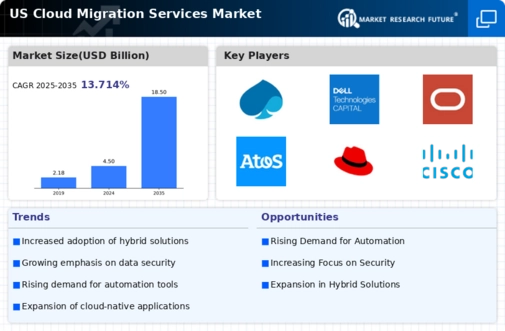Growing Demand for Scalability
The cloud migration-services market is experiencing a notable surge in demand for scalability solutions. Organizations are increasingly seeking to enhance their operational efficiency by migrating to cloud environments that allow for flexible resource allocation. This trend is particularly pronounced among small to medium-sized enterprises (SMEs) that require the ability to scale their IT infrastructure in response to fluctuating business needs. According to recent data, approximately 70% of SMEs in the US are prioritizing cloud solutions to support their growth strategies. The ability to quickly adjust resources without significant capital expenditure is a compelling driver for the cloud migration-services market, as businesses aim to remain competitive in a rapidly evolving landscape.
Cost Efficiency and Budget Optimization
Cost efficiency remains a pivotal driver in the cloud migration-services market. Organizations are increasingly recognizing the financial benefits associated with migrating to cloud-based solutions. By transitioning to the cloud, businesses can reduce their IT overhead costs, including hardware maintenance and energy consumption. Recent studies indicate that companies can save up to 30% on IT costs by adopting cloud services. This financial incentive is particularly appealing in the current economic climate, where budget optimization is crucial. As organizations strive to maximize their return on investment, the cloud migration-services market is likely to see continued growth, driven by the pursuit of cost-effective solutions.
Regulatory Compliance and Data Governance
Regulatory compliance and data governance are critical drivers in the cloud migration-services market. Organizations are under increasing pressure to adhere to various regulations, such as GDPR and HIPAA, which necessitate robust data management practices. Cloud migration services offer solutions that help businesses ensure compliance while managing their data effectively. Approximately 55% of US companies cite compliance as a primary reason for migrating to the cloud. This trend underscores the importance of selecting cloud providers that prioritize security and compliance, thereby driving growth in the cloud migration-services market as organizations seek to mitigate risks associated with data breaches and regulatory penalties.
Technological Advancements and Innovation
Technological advancements play a crucial role in shaping the cloud migration-services market. The rapid evolution of cloud technologies, including artificial intelligence, machine learning, and automation, is driving organizations to migrate to more sophisticated cloud environments. These innovations enable businesses to leverage advanced analytics and improve operational efficiencies. Recent data suggests that nearly 50% of US enterprises are planning to integrate AI-driven solutions into their cloud strategies. As organizations recognize the potential of these technologies to enhance their competitive edge, the cloud migration-services market is poised for growth, fueled by the desire to adopt cutting-edge solutions.
Enhanced Collaboration and Remote Work Capabilities
The cloud migration-services market is significantly influenced by the need for enhanced collaboration and remote work capabilities. As organizations increasingly adopt flexible work arrangements, the demand for cloud solutions that facilitate seamless communication and collaboration has surged. Cloud-based tools enable teams to work together in real-time, regardless of their physical location. This shift is reflected in the fact that over 60% of US companies are investing in cloud technologies to support remote work initiatives. The ability to access data and applications from anywhere is a compelling driver for the cloud migration-services market, as businesses seek to improve productivity and employee satisfaction.
























Leave a Comment